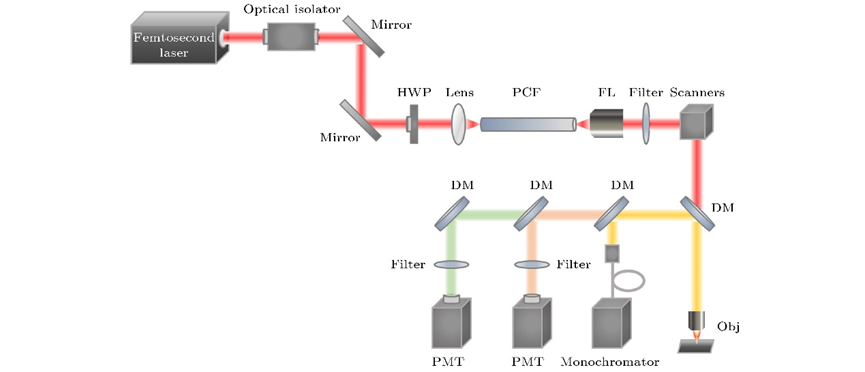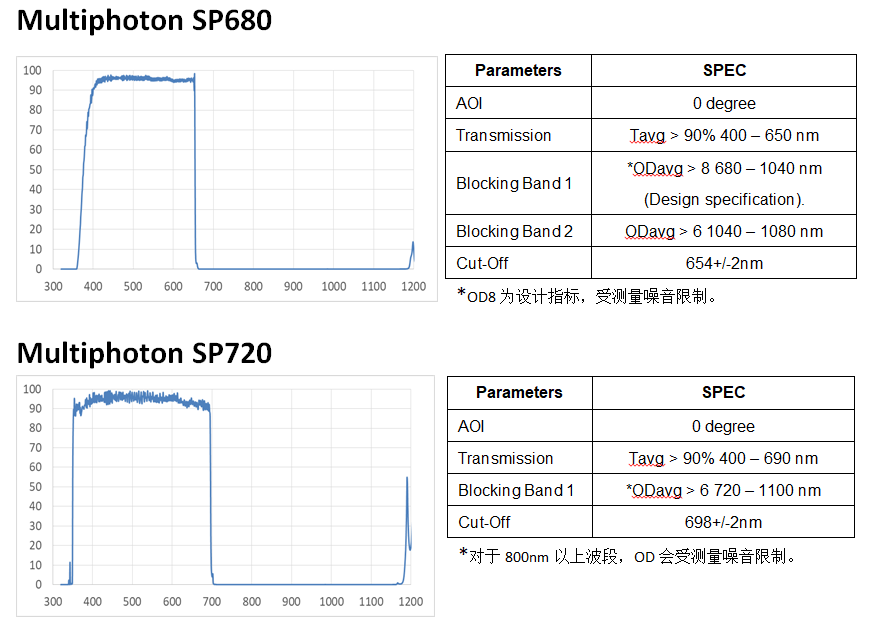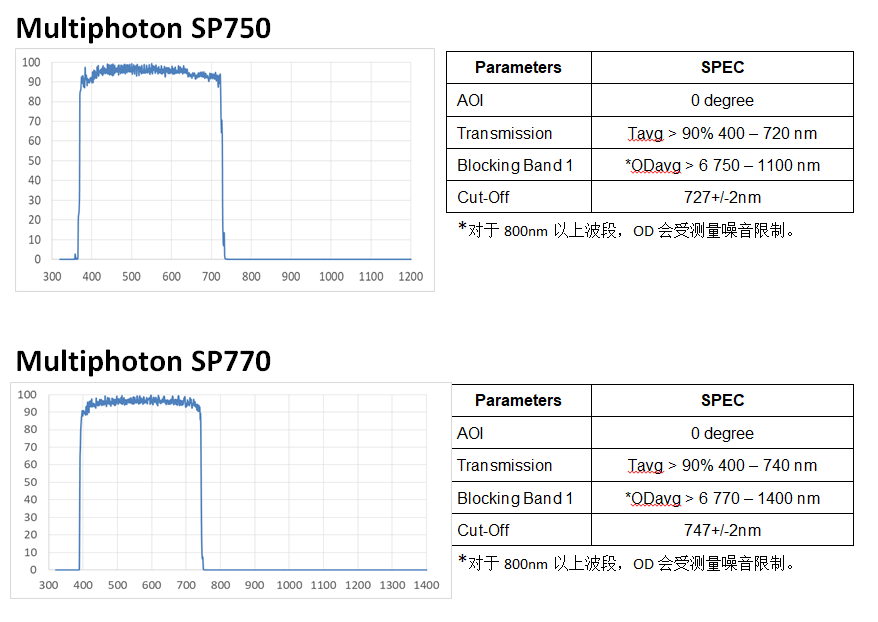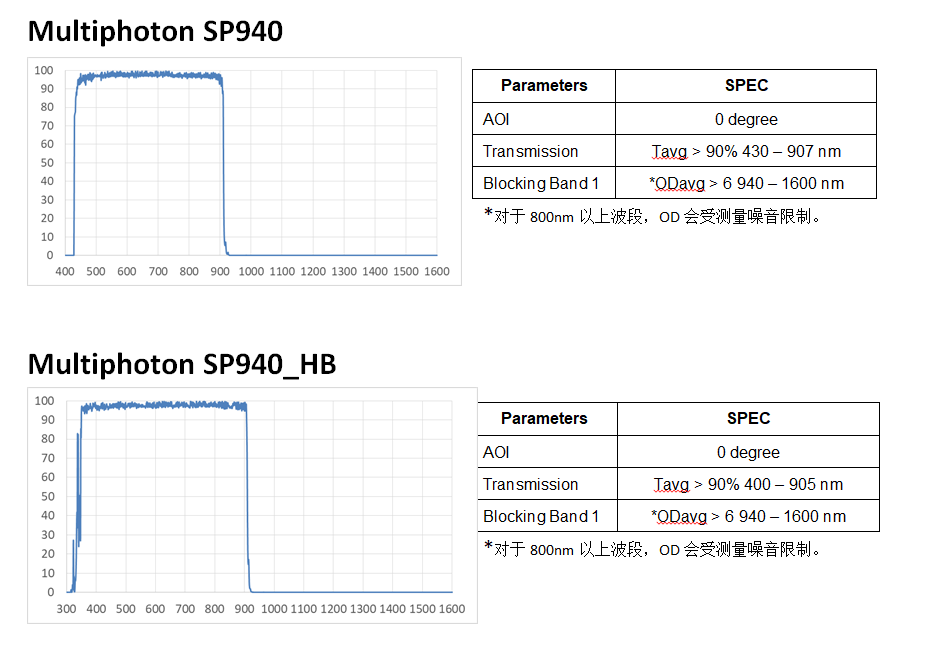

Multiphoton Shortpass Emission Filter
Nov,04,2023Due to its low invasiveness, strong penetration, and high spatial resolution, multiphoton imaging technology has become a powerful tool for biomedical research since its inception, and has achieved a series of achievements in cancer pathology, neurological diseases, and brain functional imaging. better research results. At present, the most widely used multiphoton imaging technology is two-photon excitation fluorescence microscopy imaging technology, which has great development potential in biomedical applications.
Compared with technologies such as single-photon excitation fluorescence, laser scanning confocal and wide-field imaging, multi-photon imaging technology has the following advantages:
1) The excitation light usually used in multi-photon imaging technology is near-infrared light with a longer wavelength. Compared with visible light, near-infrared light has stronger penetrating ability in biological tissues and can observe deeper information in biological tissues and invade. lower sex;
2) Multi-photon imaging can only excite fluorescence in the area near the focus of the excitation light. Therefore, multi-photon imaging technology has natural optical tomography capabilities and can better perform three-dimensional imaging of biological tissues;
3) Multi-photon imaging does not produce fluorescence in the non-focus area of the sample and can automatically suppress out-of-focus signals. Therefore, compared with wide-field imaging technology, multi-photon imaging can achieve spatial resolution close to the diffraction limit, so it can observe more detailed information in the tissue. subtle structure;
4) Compared with confocal imaging technology, multiphoton imaging technology does not require the use of pinhole filters and has high fluorescence collection efficiency.
Multiphoton excitation characteristics
Laser wavelength: Two or more photons are excited at the same time, and the excitation wavelength is 2 times or 3 times the single photon excitation wavelength.
Main lasers: Ti:Sapphire (700 – 1000nm), Cr:LiSAF (800 – 900nm).
Two-photon absorption spectra of three common multi-photon fluorescent labeling solutions. The names of the three solutions are:
Endogenous fluorescent substance (NADH)
EX excitation wavelength:340nm
EM emission wavelength:450nm
Green fluorescent protein (GFP)
EX excitation wavelength:488nm
EM emission wavelength:507nm
Green fluorescent protein (GFP)
EX excitation wavelength:532nm
EM emission wavelength:588nm

Fig1:Schematic diagram of laser scanning multicolor two-photon excitation fluorescence microscope system

Fig2:Schematic diagram of laser scanning three-photon microscope

FIG3:Schematic diagram of two-photon fiber optic endoscopic system

FIG4:680nm and 720nm optical FIlter

FIG5:750nm and 770nm optical FIlter

FIG5:790nm and 890nm optical FIlter

FIG5:940nm optical FIlter
Not only Advanced Fabrication Machine But Also Advanced Test Instrument
We have advanced coating machine and testing equipment all over the world.We regard optical coating ”advanced science“,and we know how to fabricate and test to meet client's demands.
If you want to know more about our hardware about production and testing, please click this link:
Coating Machine and Testing Instruments for Optical filter
Optical Products Inventory List
Omeda have rich experience in biomedical products,we do many projects with our clients and accumulated a lot of stock filter, the stock filters list can help you save a lot of money on sample cost.
Biomedical Filter Inventory.xlsx
Remark:In addition to common wavelengths, we warmly welcome you to customize specified wavelength, half-width, transmittance, and cut-off depth filter ; we are especially good at dual-wavelength and multi-wavelength bandpass filter .
-------------------------------------------------------------------------------------------------------------
About Hennan Omeda Technologies Co.,Ltd
Omeda is a company that focuses on the production of advanced optical and semiconductor components. Our team consists of several PhDs who study optical components and semiconductor component processing. We have extensive experience in glass molding technology,glass polishing technology, through-silicon via and through-glass via technology, optical coating technology, optical fiber device technology, lithography technology,Nanoimprint technology, free-form surface, metasurface and diffractive optical design.
Our business involved in Lidar,consumer electronics,Biomedical,3D Sensing, AR,VR,fiber communication,Laser Projection and Display,high power laser and so on. We provide advanced optical and semicondutor components for clients to make their design become real products.
Email:omedaoptics@gmail.com
Tel/Whatsapp:+86 151 1838 3837